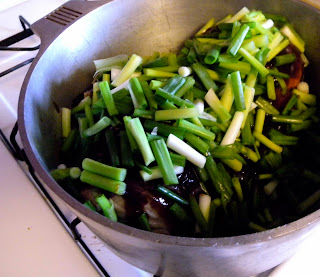Today I tried a new recipe: Hoisin Pork with Green Onions. The first thing that attracted me to the recipe was that it was easy. The second thing that attracted me was that the whole thing was cooked in one pot. Well one pot, a cutting board (washed twice), a knife (washed twice) a meat fork (washed twice) and a spatula (washed twice). Why is it that recipes for one pot meals never include a utensils count?
The ingredients are simple: Pork shoulder roast, scallions, hoisin sauce, pepper corns and brandy.
Put a couple of tablespoons of oil into a heavy pot and brown the pork. The recipe calls for a 5 1/2 lb. roast. I bought a 3 1/2 lb roast. I can't imagine wrestling a 5 1/2 lb. roast to brown it. This one was difficult enough.
Once the roast is browned, cover it with 3/4 cup of hoisin sauce. It will nicely cover the roast. Then sprinkle a teaspoon of pepper corns over the roast.
Slice three bunches of scallions in 1 inch pieces.
Cover the roast with the scallions. Don't be afraid. It looks like a lot of scallions, but you will be amazed at the final result. In the mean time, it looks like a green porcupine with a cowlick problem.

Add 1/4 c. water to the bottom of the pan. Cover the pot and put it in a 300 degree oven for 3 1/2 hours. I turned the roast after two hours. The hoisin sauce had melted to the bottom of the pan, so turning it made both sides of the roast have some cooking time in the liquid.
And this is what it looked like when I removed it from the pan 3 and 1/2 hours later. If I didn't hate the word yummy, I'd say that looks yummy.

Here's another art shot. My photographer is all about the art shots.
While the roast is resting, make the sauce. Skim as much fat off the juices left in the pan as you can. Bring to a boil. Add 1/4 c. brandy. That's right. BRANDY!!! I know that most of my readers don't know that brandy comes in bottles this small. It's like it belongs in a doll house. Or it's something the Miniatures Killer on CSI would put in a crime scene diorama. It's freaky. But never fear. They still make the big bottles. I hope I didn't scare anyone.
Simmer the sauce until it thickens. The recipe suggested that you might have to add water. I didn't.
And here is the final product. Hoisin Roast Pork with Green Onions with a side of rice.
The taste is reminiscent of mu shu pork. I wanted to wrap it a little pancake. Don't short the scallions They are lovely in the sauce.
If I were going to change anything, I'd grate a little ginger into the sauce. I think that would add a nice dimension of flavor.
Oh yeah, I'd buy a bigger bottle of brandy. The cook needs her toddy!
The recipe from Bon Appétit | October 2003
- 1 tablespoon olive oil
- 1 5 1/2-pound boneless pork shoulder (about 6 1/2 pounds with bone), trimmed, tied to hold shape
- 3/4 cup hoisin sauce
- 3 bunches green onions, cut on diagonal into 1-inch pieces (about 6 cups)
- 1 teaspoon whole black peppercorns
- 1/4 cup Scotch whisky
- 3/4 cup (or more) water
- Sliced green onions (for garnish)
Preheat oven to 300°F. Heat oil in heavy large ovenproof pot over high heat. Add pork shoulder, fat side down; brown on all sides, turning often, about 12 minutes. Remove pot from heat. Spread hoisin sauce over pork; sprinkle with green onion pieces and peppercorns. Cover pot and place in oven. Cook until pork is very tender when pierced with fork, about 2 3/4 hours, adding water to pot by 1/4 cupfuls if mixture is dry.
Remove pot from oven. Transfer pork to cutting board and tent with foil. Let pork stand 20 minutes.
Meanwhile, spoon off fat from pan juices. Stir whisky and 3/4 cup water into juices; boil 2 minutes. Add more water by tablespoonfuls if sauce is too thick, or boil to reduce sauce if too thin.
Cut pork crosswise on slight diagonal into 1-inch-thick slices. Garnish with sliced green onions. Pour pan sauce over pork and serve.
Read More http://www.epicurious.com/recipes/food/views/Slow-Cooked-Hoisin-Pork-Roast-with-Green-Onions-108627#ixzz10awVDghZ



















